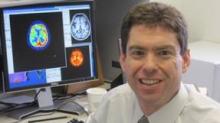BOSTON – Temporoparietal cortical thickness more effectively identified patients with early-onset or atypical dementia than did hippocampal volume, a cross-sectional analysis showed.
While hippocampal volume captured just 35% of these patients, measuring cortical thickness in that region discriminated 92%, according to research presented at the Alzheimer’s Association International Conference.
The findings have the potential to change the way in which atypical patients are diagnosed, speeding the process considerably, Dr. Gil D. Rabinovici said in an interview.
"These patients are typically young and can face a long road toward getting an accurate diagnosis – even taking several years," said Dr. Rabinovici of the University of California, San Francisco, memory and aging center. "Getting a good, clear answer early on is key to getting the support they need, including therapy for symptoms, as well as time to plan and get on disability."
An unusual symptomatic presentation makes diagnosis tricky for such patients. Instead of mentioning memory issues, they tend to complain of language and visuospatial dysfunction and problems with executive function, decision making, and judgment. "Memory can be spared in this population," Dr. Rabinovici said. "There is usually no complaint of depression, because they don’t recognize the symptoms." Initial referrals – often to an ophthalmologist or psychiatrist – are usually unhelpful, he added.
There’s also a considerable overlap between many symptoms of early-onset or atypical Alzheimer’s and frontotemporal dementia, a conundrum that contributes to a delayed diagnosis of both conditions. "Studies show that even experts have a tough time discriminating between the two," based solely on clinical presentation.
The recent inclusion of beta-amyloid brain imaging into the Alzheimer’s diagnostic criteria might help clarify the picture, he said. However, amyloid imaging agents are not widely available and, with the recent federal decision not to cover such exams, probably won’t be any time soon.
"The other option is to use imaging markers of neuronal injury that would show brain atrophy, like magnetic resonance imaging," Dr. Rabinovici said. "It’s much more accessible for most people."
But most quantitative imaging studies home in on hippocampal volume, because of its relation to memory, he said. "This is a very powerful marker in older patients, but in younger patients, there seems to be a sparing of the hippocampus, for reasons we don’t entirely understand. They seem to show more atrophy in brain areas involved with vision and language, which makes sense, given their symptoms."
To investigate this association, Dr. Rabinovici and Brendan Cohn-Sheehy evaluated hippocampal volume and cortical atrophy in a cohort of patients with typical and atypical dementias.
The group consisted of 49 patients seen at the memory and aging center: 14 with early-onset dementia, 18 with primary progressive aphasia, and 17 with posterior cortical atrophy. These patients were compared with a cohort of 7 patients with late-onset Alzheimer’s dementia from the university, 97 with confirmed Alzheimer’s from the Alzheimer’s Disease Neuroimaging Initiative (ADNI), and 166 ADNI normal controls.
The mean age of the late-onset group was 78 years, compared with 59 for the early-onset patients and 63 for those in the atypical-onset group. The ADNI controls were a mean of 75 years old and the ADNI Alzheimer’s patients, 76.
A receiver operating characteristic analysis showed that hippocampal volume discriminated late-onset Alzheimer’s patients with an 86% sensitivity. But this measurement was significantly less accurate in the early-onset group (43%) and in those with primary progressive aphasia (28%) and posterior cortical atrophy (35%).
Temporoparietal cortical thickness was a significantly more accurate method of discriminating those atypical patients, with a sensitivity of 93% for early-onset dementia, 100% for primary progressive aphasia, and 82% for posterior cortical atrophy. All told, the measurement had a 92% sensitivity for discriminating any patient with atypical dementia.
The findings could have profound implications for clinical care, Dr. Rabinivici said. "Structural imaging of some sort is already part of the standard protocol for evaluating people with cognitive complaints. But very few centers actually measure this kind of atrophy. In the typical scenario, the radiologist uses the scan to rule out strokes and tumors, but there’s no comment on atrophy. This is something that’s missing, even at really good centers."
Dr. Rabinovici said he and his colleagues think that quantitative measures like this could prove useful for these patients, "particularly in light of the environment around amyloid imaging right now. The information is already available in the MRI scan, and interpreting it correctly not only won’t break the bank, it will spare much expense in the prolonged search for a diagnosis that so many of these patients endure."


